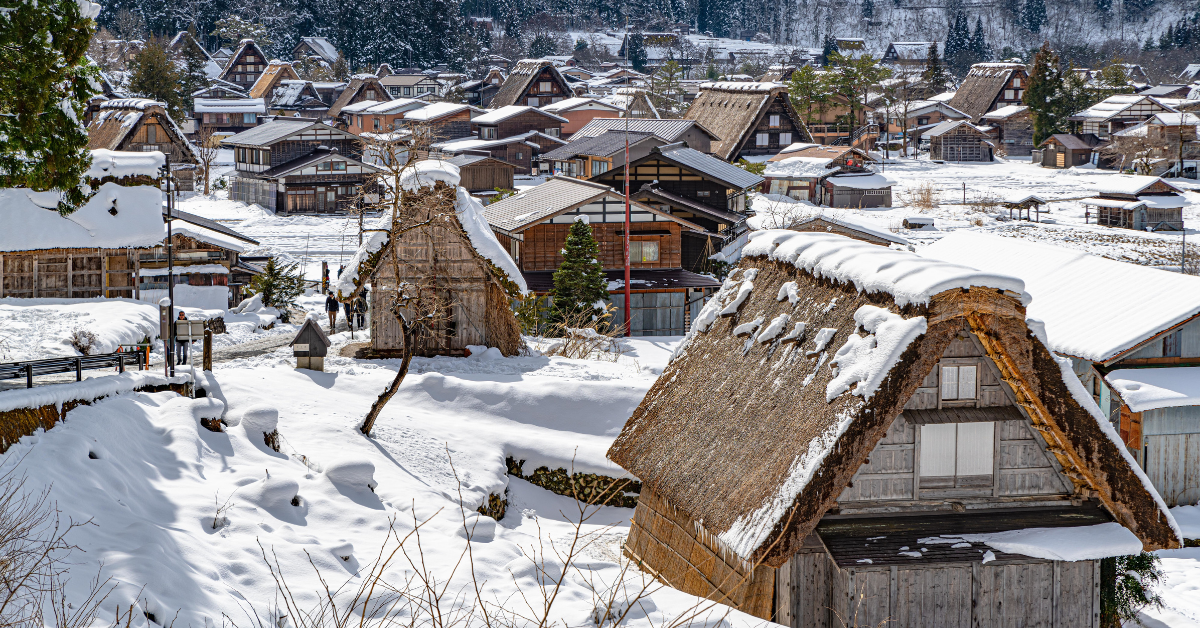Gokayama, nestled in the mountains of Toyama Prefecture, is a UNESCO World Heritage Site that preserves Japan’s original rural landscape. Unlike the bustling Shirakawa-go, it offers visitors a chance to experience authentic tranquility and living culture. Especially in winter, the illuminated snow-covered houses create a scenery that feels like stepping into a fairy tale.
What is Gokayama
Located deep in the mountains of Toyama Prefecture, Gokayama is part of the “Historic Villages of Shirakawa-go and Gokayama” UNESCO listing. Gassho-style houses are characterized by steeply sloped thatched roofs, designed with wisdom unique to heavy snowfall regions. The smoke from the hearth strengthens the thatch, allowing families to live in the same house for generations.
Japanese visitors often comment that they can “feel the wisdom of people surviving in snowy lands,” seeing Gokayama not just as a tourist site but as a living testimony of daily life.
What Japanese People Feel in Gokayama
Tranquility and Simplicity
Compared with Shirakawa-go, Gokayama has fewer tourists, making it a place where one can enjoy peaceful moments. Instead of being dominated by souvenir shops, the daily lives of local residents can be observed. Many urban visitors remark that “time flows more slowly here,” giving them a sense of calm.
What Japanese Visitors Value in Gokayama
| Impression | Explanation |
|---|---|
| Tranquility | Fewer tourists, allowing relaxed time |
| Simplicity | Less commercialized, daily life remains visible |
| Nostalgia | Reminds visitors of Japan’s fading rural scenery |
| Sense of Safety | Mountain environment calms the heart |
Winter’s Fantastical Landscape
Snow-covered Gokayama offers its most breathtaking view in winter. When illuminated at night, the contrast of light and snow creates a dreamlike atmosphere. Many describe it as “like stepping into a fairy tale,” forgetting the cold as they watch.
Winter in Gokayama and Japanese Impressions
| Feature | Japanese Impressions |
|---|---|
| Snow scenery | “It feels like my heart is cleansed” |
| Illumination | “Like living inside a dream” |
| Silence | “Sounds are absorbed by snow, it feels otherworldly” |
| Challenge | “Travel is difficult, but the experience is worth it” |
Comparison of Gokayama and Shirakawa-go
Differences Between Gokayama and Shirakawa-go
| Item | Gokayama | Shirakawa-go |
|---|---|---|
| Number of tourists | Fewer, calm atmosphere | Many, lively |
| UNESCO listing | 1995 | 1995 |
| Scale of houses | Smaller clusters of villages | Large, tourism-oriented village |
| Atmosphere | Original landscape strongly preserved | Many commercial facilities |
Japanese opinions often describe Shirakawa-go as “convenient and vibrant” while Gokayama is “quiet and simple.” Visiting both allows travelers to appreciate the diversity of Japan’s mountain culture.
Why Gokayama is Recommended for Foreigners
For international travelers, Gokayama represents “a Japan not overly commercialized.” The absence of large tourist crowds makes it easier to take photos and enjoy quiet walks.
Local cuisine is another highlight. Tofu and mountain vegetable dishes are praised as “simple yet unforgettable.”
Reasons Gokayama is Recommended for Foreigners
| Point | Explanation |
|---|---|
| Tranquility | Few crowds, calm sightseeing |
| Cultural Experience | See the actual lives of local residents |
| Food Culture | Taste authentic regional dishes |
| Photo Appeal | Snow scenery and gassho houses are strikingly beautiful |
The Value of Gokayama Seen in Japanese Impressions
Japanese visitors often describe Gokayama with words like “nostalgia,” “peace of mind,” and “living in harmony with nature.” People accustomed to city life find a sense of “human essence” here.
While the inconveniences of heavy snow are undeniable, many emphasize the ingenuity and pride that locals maintain to overcome them. These impressions are easy for foreigners to understand and highlight Gokayama as a place that conveys the essence of Japanese culture.
Conclusion
Gokayama, like Shirakawa-go, is a UNESCO World Heritage Site, but it offers a stronger sense of Japan’s original landscape due to fewer tourists. For Japanese, it is a place of “nostalgia and tranquility,” and for foreigners, it is a destination where one can “experience living culture.”
Visiting Gokayama alongside Shirakawa-go enables travelers to understand Japan’s mountain village culture more deeply and appreciate the different ways tradition and modern tourism coexist.






